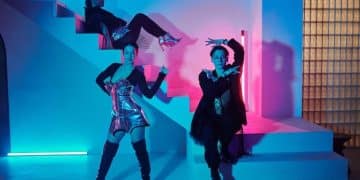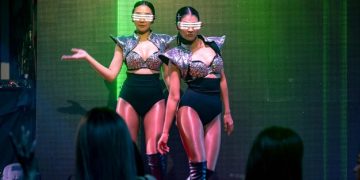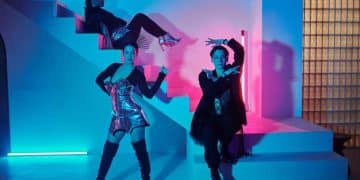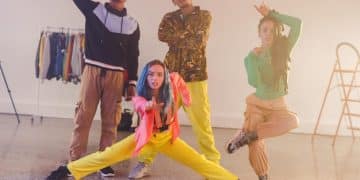Unveiling the Art of K-Pop Music Videos: Symbolism and Storytelling
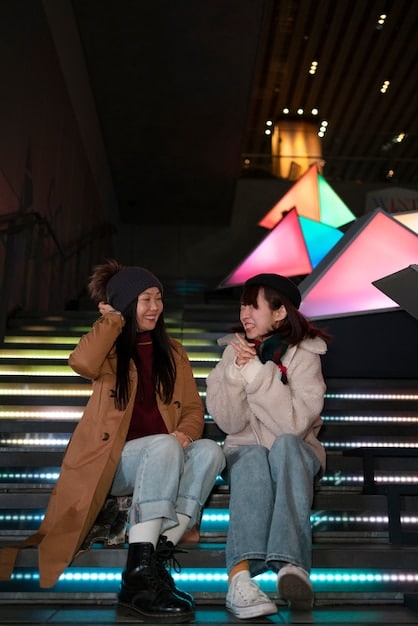
The Art of K-Pop Music Videos: Analyzing Visual Storytelling and Symbolism explores the intricate production, innovative storytelling techniques, and cultural impact of K-Pop music videos, revealing how they captivate global audiences through vibrant visuals and profound symbolism.
K-Pop music videos have become a global phenomenon, captivating audiences with their vibrant visuals, intricate storytelling, and infectious music. But beyond the catchy tunes and synchronized dance moves, lies a carefully crafted art form. Exploring The Art of K-Pop Music Videos: Analyzing Visual Storytelling and Symbolism unveils the layers of creativity that make these videos so compelling.
The Evolution of K-Pop Music Videos
K-Pop music videos have undergone a significant transformation since the early days of the genre. Initially, they were simple performances showcasing the artists’ singing and dancing abilities. However, as K-Pop grew in popularity, so did the ambition and complexity of its music videos. This evolution is a key factor in understanding the genre’s global appeal.
Early Influences and Innovations
The early K-Pop music videos drew inspiration from various sources, including Western pop music and Asian cinema. Artists began experimenting with different visual styles, incorporating elements of fantasy, science fiction, and historical dramas. This experimentation laid the groundwork for the elaborate and visually stunning videos we see today.
The Rise of Cinematic Music Videos
A pivotal moment in the evolution of K-Pop music videos was the emergence of cinematic storytelling. Videos started to incorporate complex narratives, high-quality production values, and even celebrity cameos. This shift transformed music videos from simple promotional tools into short films that enhanced the emotional impact of the music.
- Incorporation of Western pop music elements.
- Experimentation with diverse visual styles like fantasy and sci-fi.
- Emergence of cinematic storytelling and celebrity appearances.
- Improved production quality to enhance audience experience..
In conclusion, the evolution of K-Pop music videos is a testament to the genre’s commitment to innovation and artistic expression. From humble beginnings, these videos have grown into elaborate and visually stunning works of art that continue to captivate audiences worldwide.
Decoding Visual Symbolism in K-Pop
Visual symbolism is a cornerstone of K-Pop music videos, adding layers of meaning and depth to the viewing experience. These symbols can range from cultural references to abstract metaphors, all designed to enhance the narrative and emotional impact of the music. Understanding these symbols can unlock a deeper appreciation for the artistry involved.
Cultural and Historical References
Many K-Pop music videos draw inspiration from Korean history, mythology, and traditional art forms. These references can be subtle or overt, but they often serve to connect the music to the country’s cultural heritage. Recognizing these elements enriches the viewer’s understanding of the video’s message.
Color Symbolism and its Impact
Color plays a crucial role in conveying emotions and themes in K-Pop music videos. Different colors are often associated with specific feelings or ideas, allowing the directors to communicate complex messages visually. For example, red might symbolize passion or danger, while blue could represent serenity or sadness.
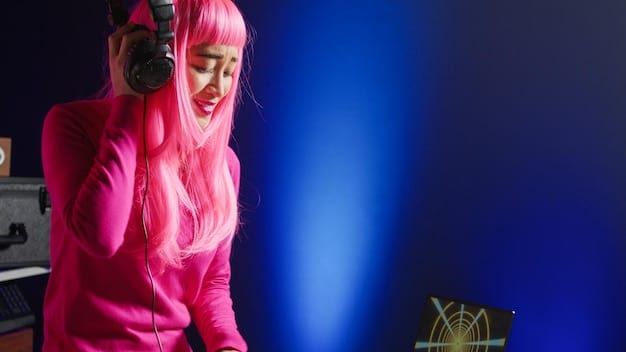
- Use of traditional Korean symbols and motifs.
- Employment of color theory to evoke specific feelings.
- Incorporation of visual metaphors to convey abstract concepts.
- Use of body language and facial expression..
To conclude, visual symbolism is a powerful tool used in K-Pop music videos to enhance the narrative and emotional impact of the music. By understanding these symbols, viewers can gain a deeper appreciation for the artistry and creativity involved in the creation of these videos.
Narrative Structures and Storytelling Techniques
K-Pop music videos often employ sophisticated narrative structures and storytelling techniques to engage their audience. These can range from straightforward narratives to more abstract and experimental approaches. Understanding these structures can help viewers appreciate the artistry involved in crafting these visual stories.
Linear vs. Non-Linear Storytelling
Some K-Pop music videos follow a linear narrative, presenting a clear and straightforward storyline from beginning to end. Others experiment with non-linear techniques, jumping between different scenes and timelines to create a more dreamlike or disorienting effect. The choice of narrative structure often depends on the song’s theme and mood.
Use of Allegory and Metaphor
Allegory and metaphor are frequently used in K-Pop music videos to convey deeper meanings and explore complex themes. These techniques allow the directors to address sensitive topics or express abstract ideas in a visually engaging way. Deciphering these allegories can be a rewarding experience for viewers.
To illustrate, the use of metaphors can amplify emotional resonance. Visual representations of water could convey feelings of sadness or cleansing, while fire could signify passion or destruction, adding layers of depth and interpretation for the viewer.
- Adoption of linear storytelling to build straightforward narratives.
- Experimentation with non-linear storytelling to create artistic effects.
- Application of allegory and metaphor to explore complex themes.
- Subtle use of cinematography and editing can make difference.
Overall, the narrative structures and storytelling techniques employed in K-Pop music videos are essential elements that contribute to their overall impact and appeal. By understanding these techniques, viewers can gain a deeper appreciation for the artistry and creativity involved in their creation.
The Role of Choreography and Performance
Choreography and performance are integral components of K-Pop music videos, showcasing the artists’ skills and adding dynamism to the visual presentation. The precision and energy of the dance routines, combined with the performers’ charisma, contribute significantly to the videos’ captivating quality.
Synchronization and Precision
One of the hallmarks of K-Pop choreography is its high level of synchronization and precision. The members of the group move in perfect unison, creating visually stunning formations and patterns. This requires countless hours of practice and dedication, highlighting the artists’ commitment to their craft.
Emotional Expression Through Dance
Dance is not just about technical skill; it’s also a powerful tool for emotional expression. K-Pop choreographers often incorporate movements that reflect the themes and emotions of the song. This allows the performers to connect with the audience on a deeper level, conveying feelings of joy, sadness, anger, or love through their bodies.
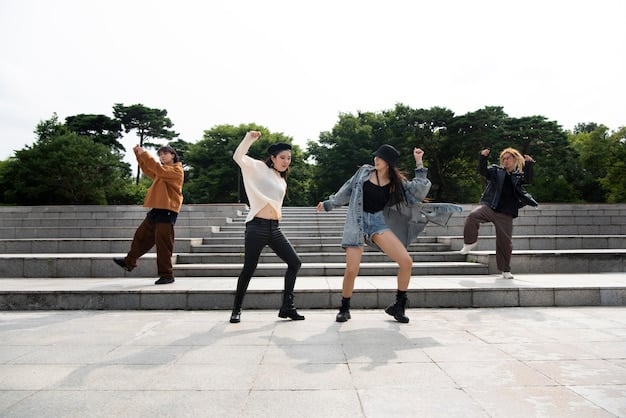
- Synchronized dance to create visually attractive formations.
- Expression of emotion through dance movements.
- Innovative choreography to complement music style.
- Dynamic stage presence of the performer
In closing, choreography and performance are essential elements of K-Pop music videos, showcasing the artists’ skills and adding dynamism to the visual presentation. The choreography’s precision and the performers’ charisma contribute significantly to the videos’ captivating quality.
Fashion and Styling in K-Pop Videos
Fashion and styling play a crucial role in K-Pop music videos, contributing to the overall aesthetic and helping to define the artists’ image. The costumes, hairstyles, and makeup are carefully chosen to complement the music and narrative, creating a visually cohesive and impactful presentation. The styling in a K-Pop music video often sets trends in youth culture around the world.
Trendsetting Styles
K-Pop artists are often seen as fashion icons, and their music videos frequently showcase the latest trends in clothing, hairstyles, and accessories. These styles can range from high fashion to streetwear, reflecting the diverse influences that shape K-Pop culture. The fashion in K-Pop videos often sparks global trends.
The Use of Visual Storytelling
Fashion and styling are not just about aesthetics; they can also be used to tell stories and convey messages. The costumes worn by the artists can reflect their characters, the themes of the song, or even the cultural context of the video. Paying attention to these details can enhance the viewer’s understanding of the video’s message.
Concisely, styling is a key component in conveying the intended message and visual appeal. Designers and stylists work in harmony to capture the song’s essence and enhance the artists’ persona, giving viewers a more immersive sensory experience.
- The latest trends in clothing styles.
- Fashion as form of visual storytelling.
- Complementing Narrative through styling.
- Cultural context of the video.
To sum up, fashion and styling are essential components of K-Pop music videos, contributing to the overall aesthetic and helping to define the artists’ image. The costumes, hairstyles, and makeup are carefully chosen to complement the music and narrative, creating a visually cohesive and impactful presentation.
Impact and Influence on Global Culture
K-Pop music videos have had a profound impact on global culture, influencing everything from music and fashion to art and technology. Their innovative approach to visual storytelling, combined with their catchy music and charismatic performers, has resonated with audiences around the world. This popularity underscores the global influence of K-Pop.
Driving Trends and Cultural Exchange
K-Pop music videos have played a significant role in driving trends and promoting cultural exchange. The videos often showcase Korean culture, language, and traditions, introducing these elements to a global audience. This has led to increased interest in Korean culture and a greater appreciation for its diversity.
Inspiring Creativity and Innovation
The creativity and innovation displayed in K-Pop music videos have inspired artists and filmmakers around the world. The videos’ use of visual effects, choreography, and storytelling techniques has pushed the boundaries of what is possible in music video production. This has led to increased innovation across various art forms.
- Promotion of K-Pop music videos and culture on a global scale.
- Encouragement of innovation and creativity.
- Fostering a global artistic community.
- Expansion of business and marketing landscape.
To conclude, K-Pop music videos have had a deep and lasting impact on global culture, influencing trends, inspiring creativity, and promoting cultural exchange. Their innovative approach to visual storytelling and their charismatic performers have captivated audiences around the world, solidifying K-Pop’s position as a global cultural force.
| Key Aspect | Brief Description |
|---|---|
| 🎵 Evolution of MVs | From simple performances to cinematic storytelling. |
| 🎨 Visual Symbolism | Use of colors, cultural references, and metaphors. |
| 💃 Choreography | Precision, synchronization, and emotional expression. |
| 🌟 Global Impact | Driving trends, inspiring creativity, and promoting culture. |
Frequently Asked Questions (FAQ)
▼
K-Pop music videos are known for their high production value, intricate choreography, and use of visual symbolism. They blend music, dance, and fashion into a captivating visual experience.
▼
Visual storytelling is crucial in K-Pop music videos. It enhances the emotional impact of the music, conveys complex themes, and engages audiences on a deeper level, making the videos more memorable.
▼
Fashion in K-Pop music videos is more than just aesthetics. It is used to define the artists’ image, set trends, and tell stories, contributing significantly to the overall visual appeal and cultural impact.
▼
K-Pop music videos have driven global trends in music, fashion, and art by showcasing Korean culture and inspiring artists worldwide. This has led to increased appreciation for Korean diversity and creativity.
▼
Common themes in K-Pop include love, heartbreak, empowerment, and social commentary. These themes are often expressed through visual metaphors, cultural references, and dynamic choreography.
Conclusion
In summary, K-Pop music videos are an art form that blends music, visuals, and storytelling into a unique and compelling package. Their global impact reflects the creativity and innovation that define the genre.
